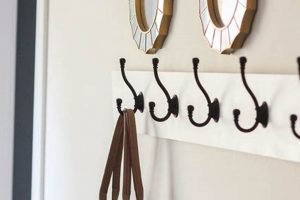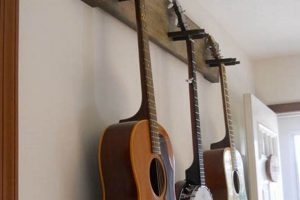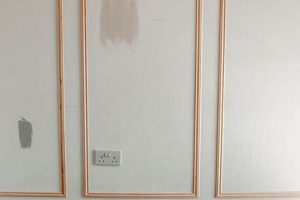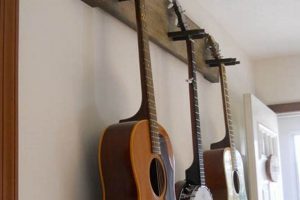The construction of a self-made instrument support affixed to a vertical surface allows for the secure display and storage of guitars. This approach enables individuals to create customized solutions for their specific needs and aesthetic preferences, often at a lower cost than commercially available alternatives. A typical example involves utilizing wood, metal, or repurposed materials to fabricate a bracket designed to cradle the instrument’s neck, preventing it from falling.
Implementing this type of storage system offers several advantages. It frees up floor space, reduces the risk of accidental damage compared to leaving the instrument on the floor, and can transform a guitar into a decorative element within a room. Historically, musicians have sought practical and visually appealing methods to store their instruments, leading to a diverse range of crafted solutions designed to protect and showcase them.
The subsequent sections will explore various design considerations, material selections, and construction techniques applicable to creating personalized solutions. These techniques will emphasize stability, instrument safety, and aesthetic integration with the surrounding environment.
Essential Considerations for Instrument Support Construction
The following guidelines address critical factors to ensure a secure and aesthetically pleasing instrument display solution.
Tip 1: Material Selection. Prioritize hardwoods like oak or maple for structural components to ensure adequate strength and longevity. Avoid softwood alternatives that may compromise load-bearing capacity.
Tip 2: Neck Support Design. Employ a “U” or “Y” shaped cradle lined with a non-reactive material, such as felt or suede, to prevent scratches and ensure a snug, secure fit around the guitar’s neck.
Tip 3: Wall Anchoring. When attaching to drywall, utilize appropriate anchors rated for the weight of the instrument plus a safety factor. Locate wall studs whenever possible for maximum stability.
Tip 4: Weight Distribution. Design the support to distribute the instrument’s weight evenly across the mounting points. This minimizes stress on individual fasteners and enhances overall security.
Tip 5: String Clearance. Account for sufficient space between the instrument and the wall to prevent string contact and potential damage. A minimum clearance of 2 inches is generally recommended.
Tip 6: Finish Application. Apply a durable, non-reactive finish to protect the wood components from moisture and environmental damage. Ensure the finish is fully cured before mounting the instrument.
Tip 7: Safety Testing. Before entrusting the support with an instrument, conduct a thorough stress test by applying a load exceeding the instrument’s weight. Monitor for any signs of instability or failure.
Adhering to these considerations will result in a dependable and visually appealing system for instrument storage and display.
The subsequent section will outline specific build plans and design variations suitable for different skill levels and aesthetic preferences.
1. Material Durability
In the context of self-fabricated guitar supports, material durability directly influences the long-term integrity and safety of the suspended instrument. The selection of construction materials represents a foundational design decision, impacting both the structural capacity and the resistance to environmental degradation. For instance, utilizing untreated pine may result in premature failure due to wood rot or warping under load, potentially causing the instrument to fall. Conversely, employing kiln-dried hardwood species, such as maple or oak, provides superior strength and stability, ensuring the support can withstand the sustained weight of the guitar without compromising its structural integrity. The cause-and-effect relationship is clear: inadequate material durability leads to a higher risk of failure and potential damage to the instrument.
The practical significance of understanding material durability manifests in the selection process. A common error involves using readily available but unsuitable materials, driven by cost considerations or lack of knowledge. An example is the use of particleboard or MDF, which, while inexpensive, lack the necessary tensile strength and are highly susceptible to moisture damage. A guitar supported by such a structure is at significant risk. A more informed approach would involve researching material properties, considering the instrument’s weight, and opting for materials with a proven track record in load-bearing applications. Further, the application of protective finishes, like polyurethane or varnish, enhances the material’s resistance to moisture and UV exposure, thereby extending its lifespan and reducing the likelihood of structural compromise.
In summation, material durability is a critical determinant of the overall success and reliability of a self-constructed guitar support. Overlooking this aspect can result in catastrophic consequences, including instrument damage or even personal injury. By prioritizing the selection of robust and resilient materials, coupled with appropriate protective measures, individuals can create a secure and aesthetically pleasing display solution that provides long-term peace of mind. Challenges may include sourcing appropriate materials and acquiring the necessary skills for proper joinery and finishing, however, the investment in these areas is essential to ensure the instrument’s safety and the support’s longevity.
2. Neck Support
In the realm of self-constructed guitar mounting apparatuses, the design and implementation of the neck support mechanism are of paramount importance. This component directly interfaces with the instrument, bearing its weight and preventing slippage or damage. Its effectiveness is therefore crucial to the overall functionality and safety of the wall-mounted storage system.
- Cradle Design and Material Compatibility
The cradle, typically “U” or “Y” shaped, must conform precisely to the contours of the guitar’s neck. Incompatible shapes can cause pressure points or instability. The material selection also directly impacts the instrument’s finish. Abrasive materials or those with reactive chemical properties can cause scratches, discoloration, or even dissolve the lacquer. Inert materials like felt, suede, or specific closed-cell foams are commonly employed to mitigate this risk. The chosen material should be tested for compatibility before long-term use.
- Load Distribution and Structural Integrity
The neck support must distribute the guitar’s weight evenly to prevent undue stress on specific areas of the neck. Concentrated pressure can lead to warping or even structural failure of the instrument’s neck joint over time. The support’s design should accommodate the guitar’s center of gravity, ensuring the instrument hangs securely and without excessive strain. The strength of the materials used in the neck support construction, and its attachment to the overall wall hanger structure, must be sufficient to withstand sustained loads. Testing with weights exceeding the instruments mass is a prudent precaution.
- Adjustability and Instrument Compatibility
Variations in neck thickness and profile among different guitar models necessitate consideration of adjustability in some implementations. Fixed-size cradles may not accommodate all instruments effectively, leading to either a loose fit (compromising security) or excessive pressure (risking damage). Adjustable designs, employing sliding mechanisms or interchangeable inserts, can provide a more versatile solution. When adapting a design, guitar makers must also consider instruments with non-standard headstock angles.
- Safety Mechanisms and Fall Prevention
Beyond the basic cradle design, some implementations incorporate additional safety mechanisms to prevent accidental dislodgement of the guitar. These may include retaining straps, locking mechanisms, or strategically placed protrusions that secure the instrument within the cradle. The effectiveness of these mechanisms must be rigorously tested, simulating real-world scenarios where the hanger might be bumped or jostled. The design should prioritize ease of use, allowing for quick and convenient removal and replacement of the guitar while maintaining a high level of security.
The facets of neck support are inextricably linked to the overall success of the self-fabricated guitar hanger. Compromising on any of these aspects can lead to instrument damage or even complete failure of the hanging system. A meticulous approach to design, material selection, and testing is essential to ensure the long-term safety and security of the instrument.
3. Wall Security
The integrity of any self-constructed guitar support system hinges critically on the method of its securement to the wall structure. Insufficient or improperly executed wall attachment compromises the entire system, irrespective of the quality of other design elements. The potential consequences range from instrument damage to personal injury; therefore, robust wall security measures are paramount.
- Stud Location and Utilization
Directly affixing the hanger to wall studsthe vertical framing membersoffers the most reliable support. Stud finders, both magnetic and electronic, aid in locating these. Fasteners penetrating a stud provide significantly greater holding power than those anchored solely in drywall. The spacing of the studs, typically 16 or 24 inches on center, dictates the potential mounting positions. Misidentification of stud location or inadequate fastener length reduces the system’s load-bearing capacity.
- Anchor Selection and Load Rating
When stud mounting is not feasible, drywall anchors become necessary. A variety of anchor types exist, including expansion anchors, toggle bolts, and self-drilling anchors. Each possesses a specific load rating, indicating the maximum weight it can safely support. Selecting an anchor with an insufficient load rating for the guitar’s weightincluding a safety factorincreases the risk of failure. Furthermore, improper installation of the anchor diminishes its effectiveness. A thorough understanding of anchor types and installation procedures is essential.
- Fastener Specifications and Material Compatibility
The fasteners used to attach the hanger to the wall studs or anchors must be of appropriate length, diameter, and material. Short screws may not penetrate sufficiently into the stud, while excessively long screws can protrude through the wall. The screw material must be compatible with both the hanger material and the wall structure to prevent corrosion or galvanic reactions that could weaken the connection. The fastener head design must also be suitable for the mounting hardware to ensure a secure and flush fit.
- Installation Technique and Verification
Proper installation technique is critical to achieving the rated load capacity of the chosen attachment method. This includes pre-drilling pilot holes, using appropriate tightening torque, and avoiding over-tightening, which can strip threads or damage the wall material. Following installation, the stability of the hanger must be thoroughly verified. This can involve applying a test load exceeding the instrument’s weight and visually inspecting for any signs of movement, stress, or wall damage. Immediate corrective action is required if any instability is detected.
These components of wall security are interdependent. Even if one is absent, the integrity of your DIY guitar wall hanger design will fail under the weight and use. Employing inferior components, poor installation habits, and non-durable choices all contribute to the failure of the structure, which can harm more than just the guitar.
4. Weight Distribution
Within the context of a self-constructed guitar support, weight distribution represents a critical engineering consideration influencing structural integrity and instrument safety. Uneven load bearing can induce stress concentrations, leading to premature material fatigue or catastrophic failure of the mounting system. The cause is a design that neglects to account for the guitar’s center of gravity, resulting in excessive strain on specific points of attachment. The effect is a heightened risk of the instrument falling, incurring damage, and potentially causing injury. One example includes designs where the neck support is inadequately aligned with the instrument’s center of mass, causing the entire load to be borne primarily by one side of the hanger.
The implementation of weight distribution principles manifests in several design choices. For instance, incorporating a wider mounting plate distributes the load across a larger surface area of the wall, reducing stress on individual fasteners. Similarly, using multiple attachment points, strategically positioned to coincide with the instrument’s center of gravity, can equalize the load distribution. The practical application of these concepts requires precise measurement and careful planning to ensure the support is balanced and stable. For example, when constructing a hanger for a heavier bass guitar, reinforcement of the mounting structure and the utilization of higher-rated wall anchors become imperative due to the increased gravitational force.
In summation, a comprehensive understanding of weight distribution is indispensable for constructing a reliable and safe guitar mounting system. Overlooking this aspect can render even the most aesthetically pleasing design structurally unsound. Challenges may arise in accurately determining the instrument’s center of gravity and selecting appropriate materials and attachment methods to accommodate the load. Addressing these challenges through meticulous planning and adherence to sound engineering principles ensures the long-term stability of the hanger, safeguarding the instrument and minimizing the risk of accidents.
5. Aesthetic Integration
In the context of self-constructed instrument supports, aesthetic integration refers to the harmonious blending of the mounting system’s visual attributes with the surrounding environment and the instrument itself. The cause of neglecting this aspect results in a visually discordant display, diminishing the overall aesthetic appeal of the space and potentially detracting from the inherent beauty of the guitar. The importance of aesthetic integration stems from the dual function of the hanger: not only to provide secure storage but also to serve as a decorative element. A mismatched style or finish can disrupt the visual flow of a room, rendering the hanger an eyesore rather than an enhancement. A real-life example involves a rustic, reclaimed wood hanger installed in a modern, minimalist apartment. The contrasting styles clash, creating a visual disconnect that undermines the intended aesthetic.
The practical significance of understanding aesthetic integration is evident in the design choices made during construction. This includes selecting materials, finishes, and mounting hardware that complement the existing dcor and the guitar’s style. For instance, a sleek, metal hanger with concealed mounting hardware might be appropriate for a contemporary space and a modern guitar. Conversely, a handcrafted wooden hanger with visible joinery could enhance the charm of a traditional room and a vintage instrument. The choice of stain or paint color should also align with the color palette of the room to create a cohesive visual experience.
Aesthetic integration presents challenges such as balancing personal preferences with broader design principles and achieving a seamless blend between the functional and decorative aspects of the hanger. Overcoming these challenges requires careful planning, attention to detail, and a willingness to consider the overall visual impact of the mounting system. Ultimately, successful aesthetic integration transforms the guitar hanger from a mere storage device into a curated element that enhances the aesthetic quality of the space while showcasing the instrument in its best light.
Frequently Asked Questions
This section addresses common inquiries regarding the design, construction, and implementation of self-fabricated guitar mounting systems.
Question 1: Is professional carpentry experience required to construct a safe and reliable guitar support?
While advanced woodworking skills can be beneficial, fundamental construction principles and careful execution are sufficient. Resources such as online tutorials and detailed plans can guide individuals through the process. Prioritizing structural integrity over complex joinery is advised for novice builders.
Question 2: What types of materials are unsuitable for self-made guitar supports?
Materials lacking sufficient structural strength or prone to degradation should be avoided. Examples include particleboard, MDF, and untreated softwoods. Materials that may react with the instrument’s finish, such as certain plastics or unsealed metals, are also inappropriate.
Question 3: How can one ensure the selected wall anchors are adequate for supporting the weight of a guitar?
Consult the manufacturer’s specifications for the load rating of each anchor. Select anchors with a rated capacity exceeding the guitar’s weight, factoring in a safety margin of at least 25%. Ensure the anchors are appropriate for the wall material (drywall, plaster, etc.) and are installed according to the manufacturer’s instructions.
Question 4: What measures can be taken to prevent damage to the guitar’s finish from contact with the support?
Line the instrument contact points with a non-reactive material, such as felt, suede, or closed-cell foam. Ensure the chosen material is free of abrasive particles and does not contain chemicals that could degrade the finish. Regularly inspect the lining for wear or damage and replace as needed.
Question 5: How does one determine the optimal placement height for a guitar support?
Consider the player’s height and arm reach to facilitate easy access to the instrument. Ensure sufficient clearance from the floor to prevent accidental impacts and adequate headroom to prevent contact with the ceiling. Experiment with different heights to find the most comfortable and practical position.
Question 6: What are the potential legal liabilities associated with constructing and installing a guitar support that fails and causes damage or injury?
Individuals assume responsibility for the safety and integrity of their self-constructed projects. In the event of a failure resulting in damage or injury, they could be held liable for negligence. Adhering to sound construction practices, using appropriate materials, and implementing thorough safety testing are crucial to mitigating this risk. Consulting with a qualified professional is recommended if uncertainty exists.
Proper application of the preceding recommendations minimizes the potential for instrument damage or personal injury. Safety remains the guiding principle.
The final section will summarize the key takeaways for creating functional and aesthetically pleasing supports.
Conclusion
This exploration of the “diy guitar wall hanger” reveals a confluence of design considerations, material sciences, and construction techniques. Successful implementation necessitates a comprehensive understanding of load-bearing capacities, instrument protection, and aesthetic principles. Diligent adherence to established safety protocols remains paramount throughout the design and construction process.
The crafting of a “diy guitar wall hanger” represents a commitment to both instrument preservation and creative expression. Responsible application of the presented knowledge ensures a secure and visually integrated storage solution. Continued refinement of design and construction methodologies will contribute to the ongoing evolution of this specialized craft.







